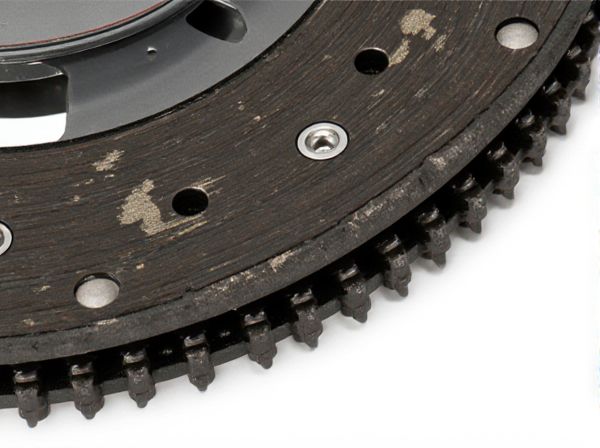
Photo illustration: Sintered Iron Clutch vs Kevlar Clutch
Sintered iron clutches offer exceptional heat resistance and durability, making them ideal for high-performance or heavy-duty applications where consistent friction and long lifespan are crucial. Kevlar clutches provide smoother engagement and reduced noise, enhancing ride comfort and longevity under normal driving conditions. Your choice depends on whether you prioritize ultimate strength and heat tolerance or a quieter, more comfortable driving experience.
Table of Comparison
| Feature | Sintered Iron Clutch | Kevlar Clutch |
|---|---|---|
| Material Composition | Metallic Sintered Iron | Synthetic Kevlar Fibers |
| Heat Resistance | High (up to 800degC) | Moderate (up to 500degC) |
| Durability | Excellent, withstands heavy use | Good, wears faster under extreme load |
| Engagement Feel | Aggressive, quick bite | Smoother, progressive engagement |
| Noise Level | Higher due to metallic contact | Lower, quieter operation |
| Applications | Racing, high-performance vehicles | Street, daily driving, mild performance |
| Cost | Higher initial cost | More affordable |
Introduction to Sintered Iron and Kevlar Clutches
Sintered iron clutches are made from powdered iron particles fused under high heat and pressure, offering exceptional heat resistance and durability ideal for high-performance and heavy-duty applications. Kevlar clutches utilize synthetic fiber known for its lightweight properties, high tensile strength, and smooth engagement, making them suitable for street and racing use where smoother power transfer and reduced wear are desired. Both materials deliver distinct advantages in clutch performance, with sintered iron excelling in thermal stability and Kevlar providing enhanced drivability and longevity.
Material Composition and Manufacturing Process
Sintered iron clutches are made from powdered iron particles fused under heat and pressure to create a durable, high-friction material ideal for heavy-duty applications. Kevlar clutches utilize aramid fiber reinforced composites, offering a lighter alternative with superior heat resistance and reduced wear compared to metal-based counterparts. The manufacturing process of sintered iron involves powder metallurgy techniques, while Kevlar clutches are typically fabricated through layering and bonding aramid fibers with resins.
Performance Comparison: Sintered Iron vs Kevlar Clutch
Sintered iron clutches offer superior heat resistance and durability, making them ideal for high-performance and heavy-duty applications where intense friction and high temperatures are common. Kevlar clutches provide smoother engagement and longer wear life under moderate loads, excelling in street and everyday driving conditions with less noise and vibration. Performance-wise, sintered iron clutches deliver more aggressive power transfer and better torque capacity, whereas Kevlar clutches prioritize comfort and consistent performance over prolonged use.
Heat Resistance and Thermal Stability
Sintered iron clutches exhibit superior heat resistance and thermal stability due to their metal composition, allowing them to withstand high temperatures without significant degradation. Kevlar clutches provide excellent heat tolerance but are more prone to wear and reduced thermal stability under prolonged extreme heat conditions. This makes sintered iron clutches ideal for heavy-duty applications requiring consistent performance under high thermal stress.
Durability and Wear Characteristics
Sintered iron clutches offer superior durability and high thermal resistance, making them ideal for heavy-duty applications with prolonged high friction and heat exposure. Kevlar clutches provide excellent wear characteristics with smoother engagement and reduced noise but wear faster under extreme temperatures and heavy loads. The choice depends on the balance between long-lasting performance and smooth operation under specific driving conditions.
Friction Coefficient and Engagement Feel
Sintered iron clutches offer a higher friction coefficient, typically around 0.35 to 0.45, resulting in a more aggressive engagement feel ideal for high-performance or racing applications. Kevlar clutches have a lower friction coefficient, approximately 0.20 to 0.30, providing smoother and more progressive engagement, which enhances drivability and reduces shudder during clutch operation. The choice between these materials impacts clutch responsiveness and durability, with sintered iron excelling in heat resistance and torque capacity, while Kevlar prioritizes comfort and longevity.
Applications: Best Use Cases for Each Clutch Type
Sintered iron clutches excel in heavy-duty applications such as racing cars, motorcycles, and industrial machinery due to their high thermal resistance and durability under extreme conditions. Kevlar clutches are ideal for street vehicles, daily commuters, and light off-road use, offering smooth engagement, reduced noise, and enhanced wear resistance. Selecting sintered iron is best when high torque and heat dissipation are priorities, while Kevlar suits scenarios requiring less aggressive performance and longer service life.
Maintenance Requirements and Longevity
Sintered iron clutches require frequent maintenance due to their aggressive friction material, which causes faster wear but offers superior heat resistance and high torque capacity. Kevlar clutches demand less maintenance with smoother engagement and longer service intervals, ideal for everyday driving and moderate performance use. While sintered iron clutches have a shorter lifespan under heavy use, Kevlar clutches provide enhanced longevity and reliability in varied driving conditions.
Cost Analysis: Initial Investment and Long-Term Value
Sintered iron clutches typically have a higher initial investment due to their robust metal composition, but they offer greater durability and heat resistance, making them cost-effective for high-performance and heavy-duty applications. Kevlar clutches, while often cheaper upfront, provide excellent friction characteristics with lighter weight and quieter operation; however, they may wear out faster in extreme conditions, leading to more frequent replacements. Evaluating long-term value depends on usage patterns, as sintered iron clutches reduce downtime and maintenance costs, whereas Kevlar clutches suit lighter, everyday driving where initial savings are prioritized.
Which Clutch Should You Choose? Expert Recommendations
Sintered iron clutches offer superior heat resistance and durability for high-performance or heavy-duty applications, making them ideal for racing or off-road vehicles. Kevlar clutches provide smoother engagement, reduced noise, and longer wear life, suitable for everyday driving and vehicles prioritizing comfort and longevity. Experts recommend choosing sintered iron for aggressive driving conditions and Kevlar for consistent, low-maintenance performance in standard use.
 caratoz.com
caratoz.com